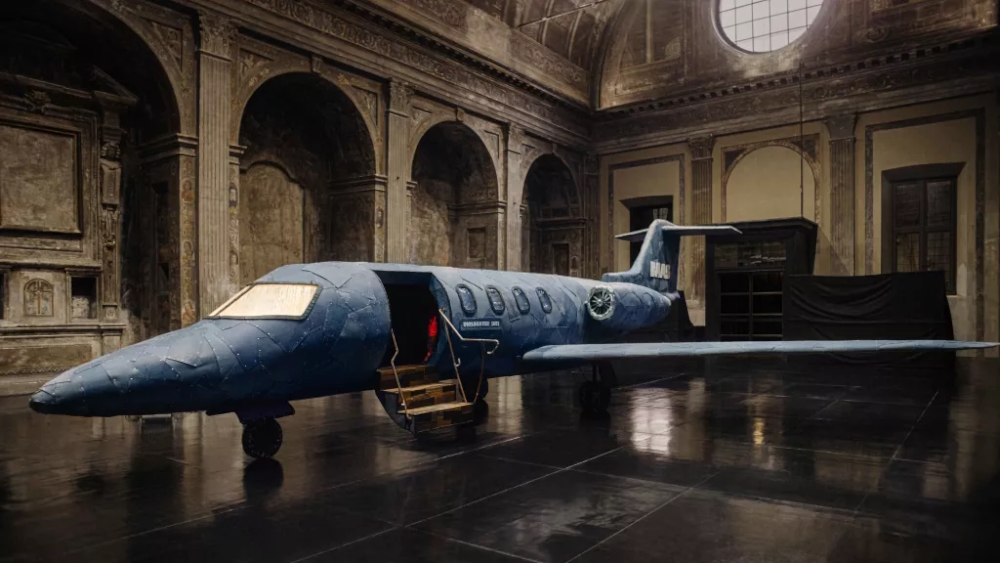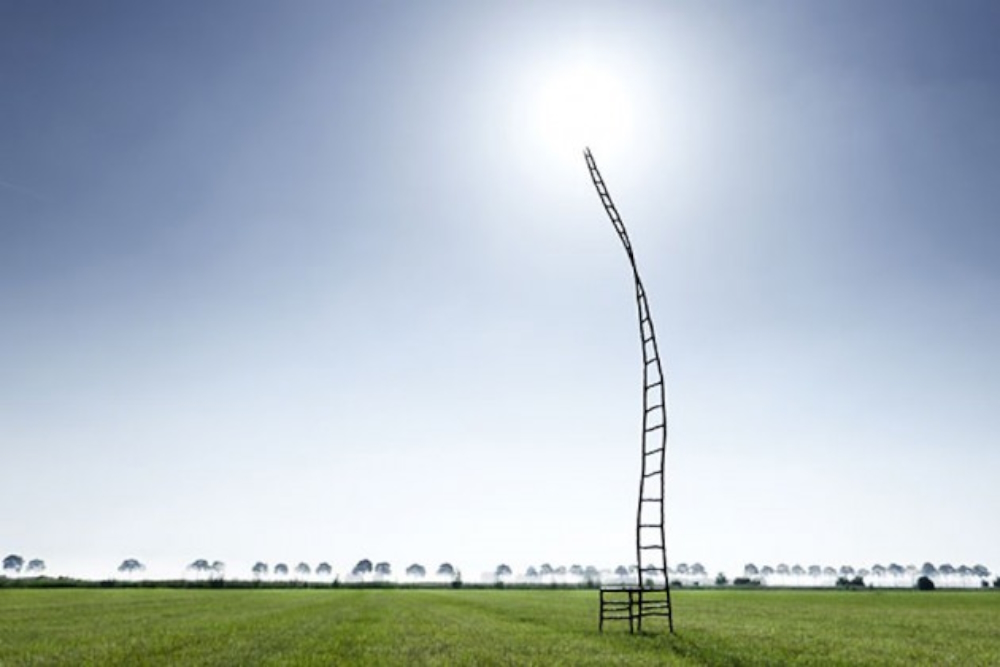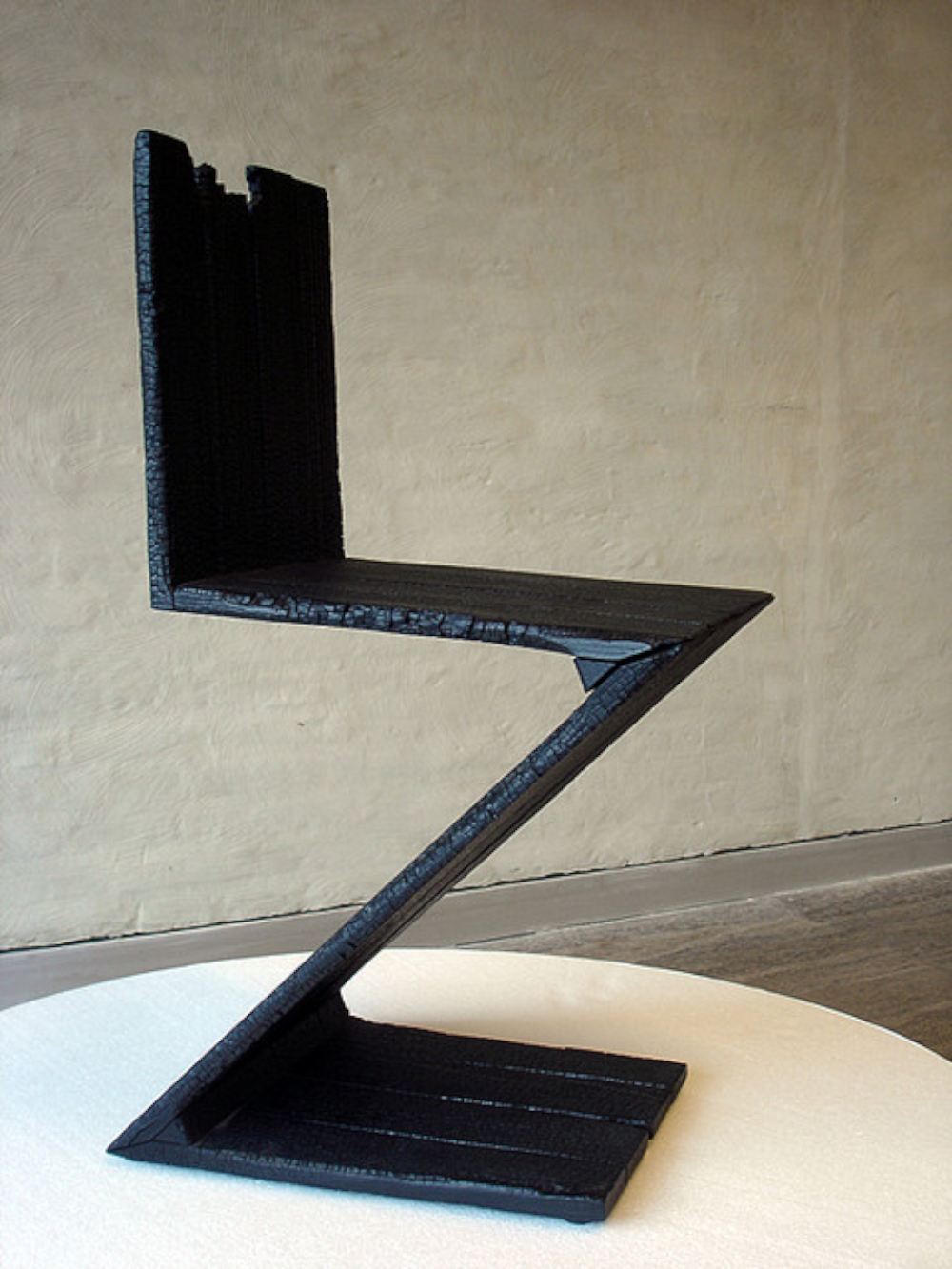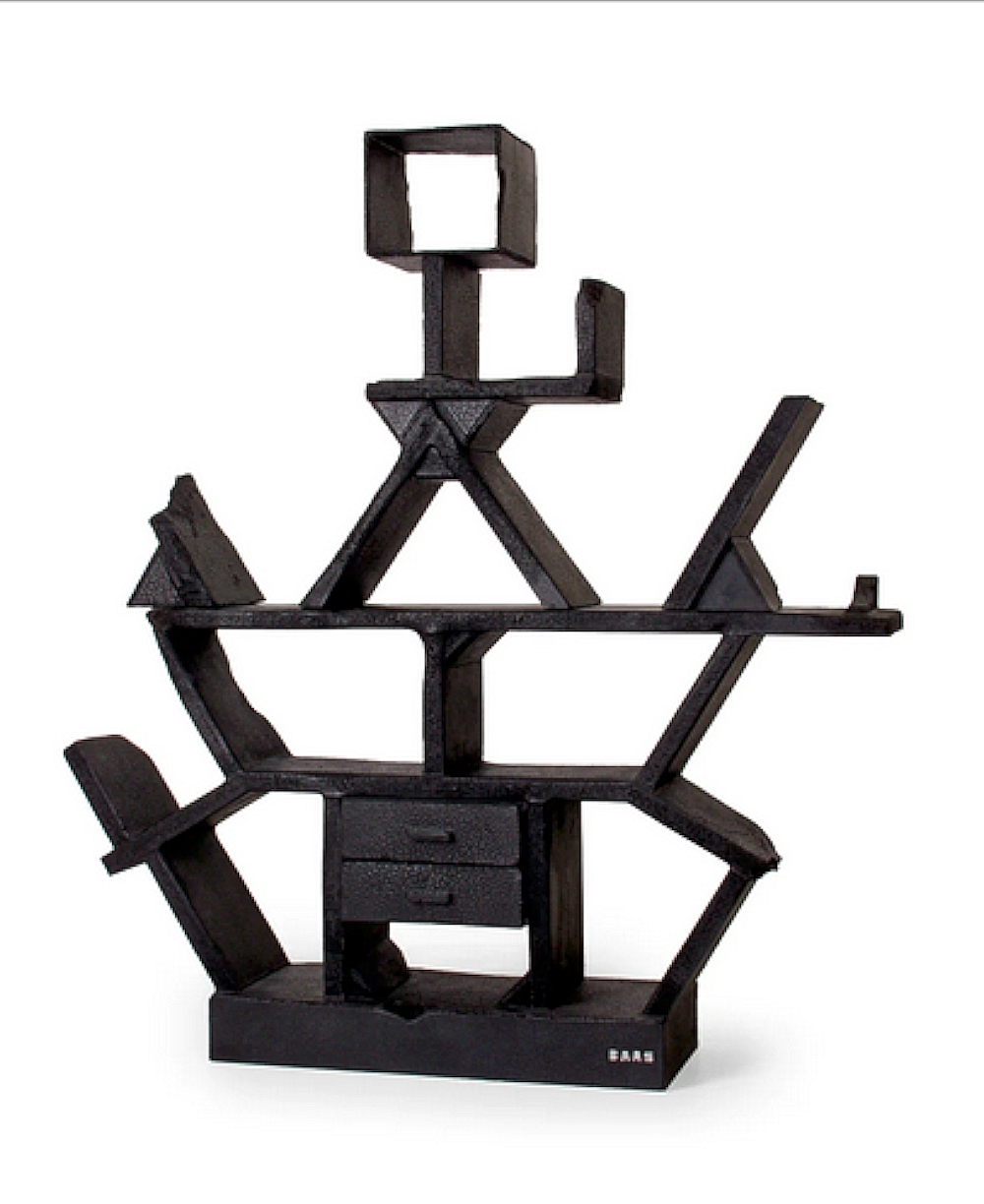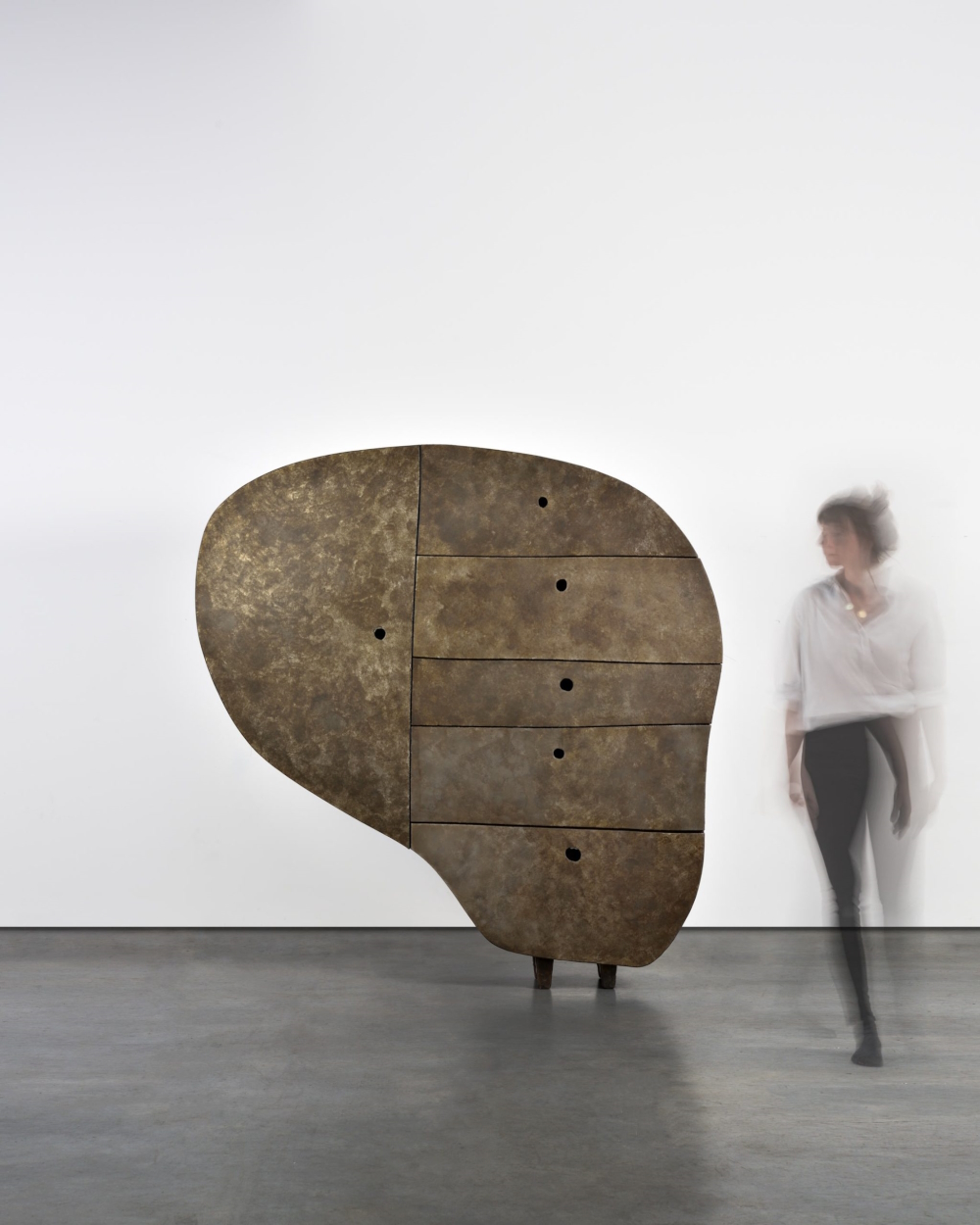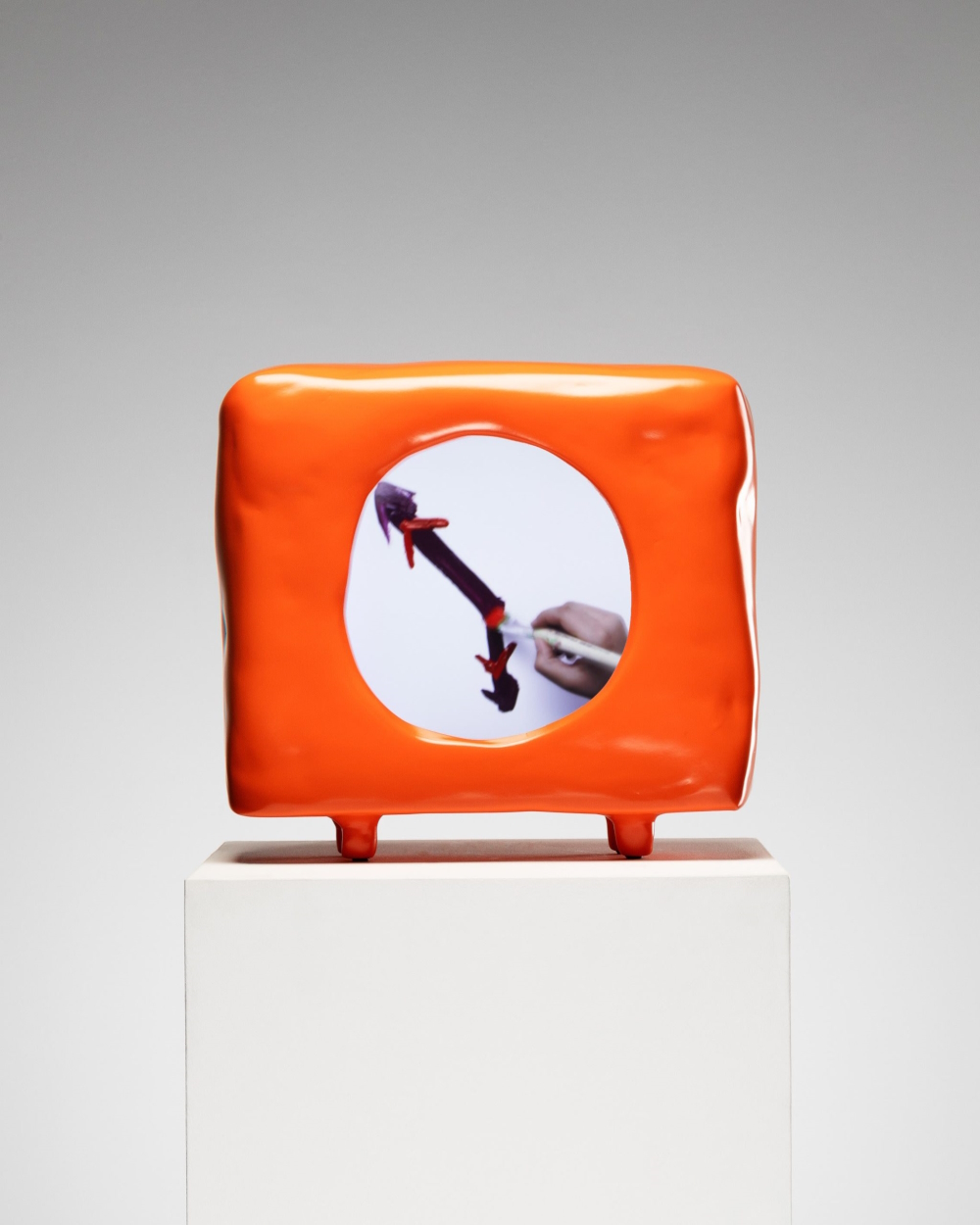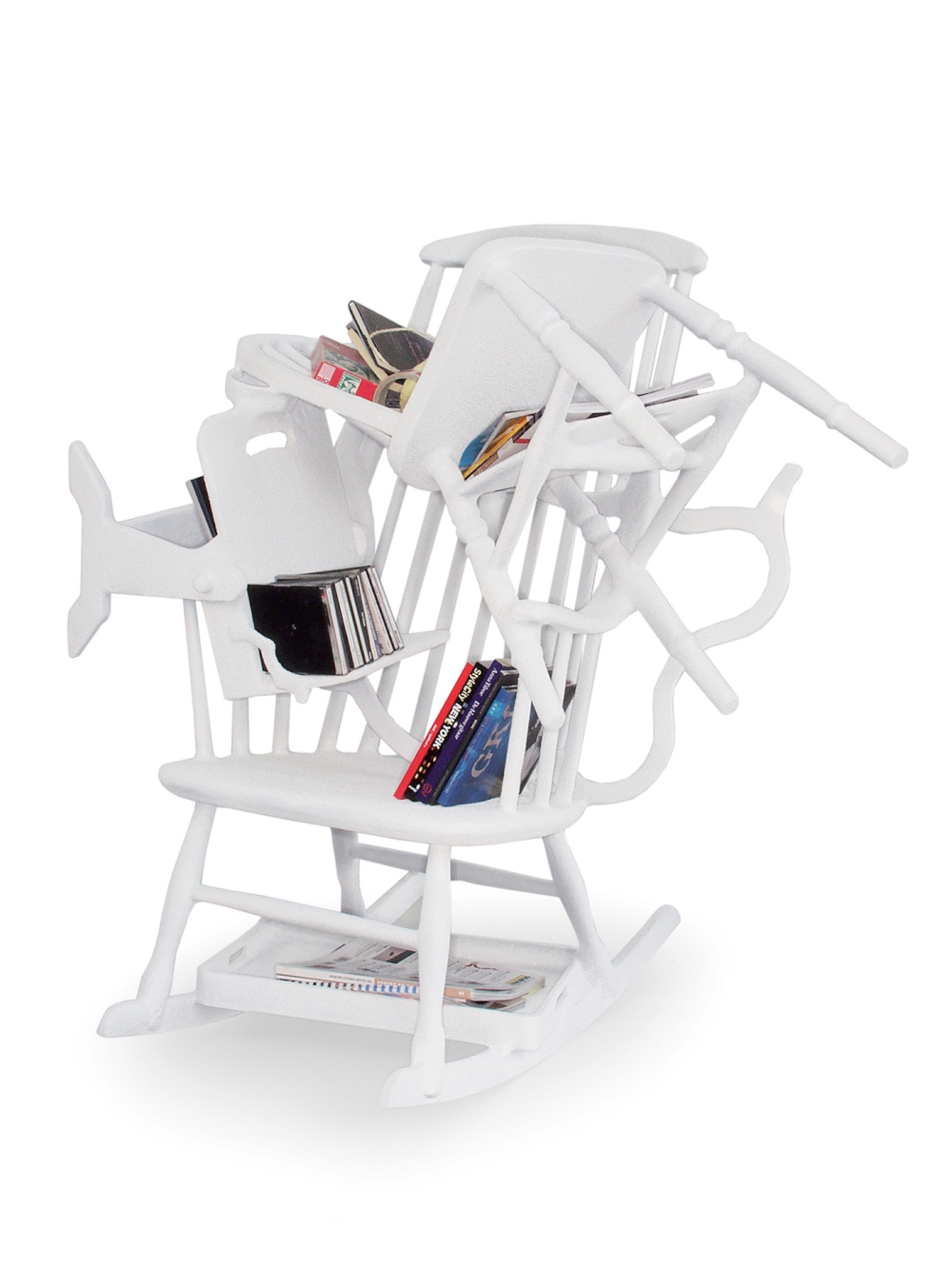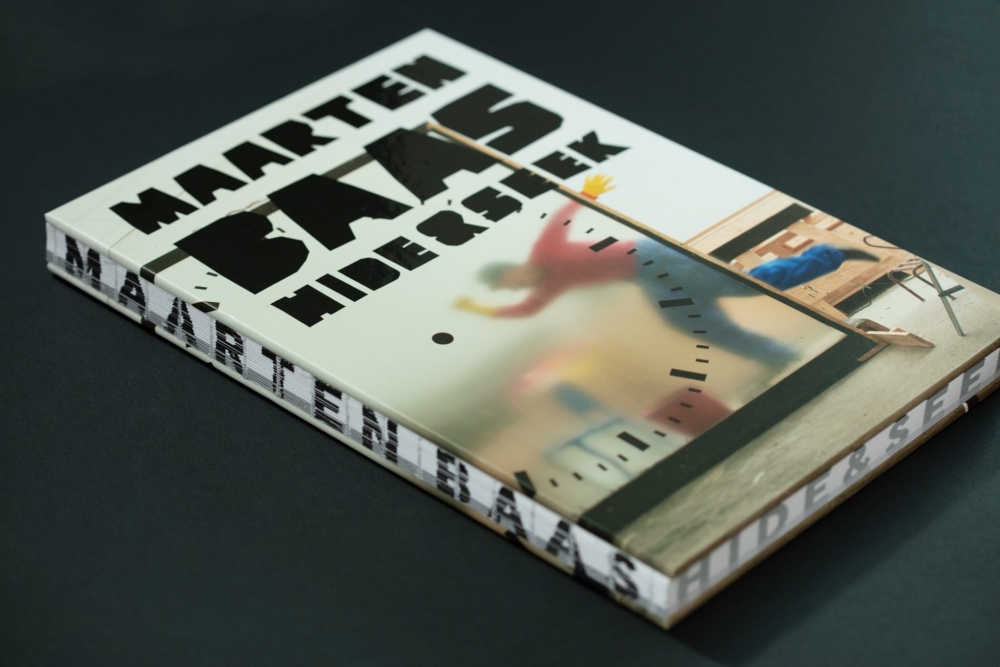Maarten Baas
rebellious designer / artist
Germany / The Netherlands
A 15 meter-long airplane wrapped in recycled denim as a symbol of luxury contrasted with sustainable material. A five meters tall empty chair that reaches up to the sky and symbolizes repression. A three meters high art clock in the Lounge 2 at Amsterdam’s Schiphol Airport „that features a video of a man in work uniform behind the translucent clock face painstakingly painting the time minute by minute“ (slate.com). These artworks are huge, even so this creative produces in smaller sizes also – like his famous series ‚Smoke‘ (old chairs and tables that are coated in a transparent epoxy resin for maintaining their shape prior to burn them) or furnitures modeled by hand with synthetic clay over a metal frame and then painted. The New York Times listed both ‚Smoke‘ and ‚Clay‘ in its ‚Top 25 Design Classics of the Future‘! Their maker isn‘t only the first Dutch but the youngest too to be recognised as Designer of the Year during Design Basel/Miami. With an award as such and worldwide recognition it’s no wonder that groningermuseum.nl writes that this man „is considered one of the most influential artist designers of the early 21st century. His works straddle boundaries between art and design.“ In an interview on nodusrug.it the multifaceted creator, whose oeuvre is collected by actor Brad Pitt or musician Kanye West, said: „Having a style is like being in jail!“
Maarten Baas
rebellious designer / artist
Germany / The Netherlands

Failing many times at an Academy and having been „a very bad student“ (by self-description) doesn’t exclude one from becoming successful. Just look at the career of Maarten Baas to whom all that applies.
In 1996 the native German (* 19 February 1978 in Arnsberg/West Germany, growing up in The Netherlands) started his studies at one of the most radical design schools in the world, the renowned Design Academy in Eindhoven (The Netherlands) including several months in 2000 at the Politecnico di Milano (Italy). Not after the official four years, but two additional ones, he graduated in 2002 with the first presentation of ‚Smoke‘. On idesign.wiki Maarten Baas explained the idea therefore: “I was always amazed at the reason why we buy things and do not touch them, because we want things to remain unchanged, why do we think that symmetry and smoothness are beautiful? What happens if I try to change the face of things, for example by shooting and burning? The thing has acquired a character, has received a new aesthetic, a different meaning, becoming more emotional and personal.“
With the ‚Clay‘ series in 2006 Maarten Baas, who had started his own studio in the previous year, wanted to make a naive chair. Three years later he launched the ‚Real Time‘ series with its 12-hours films of performances. “Real time is a term that is used in the film industry,” Baas said in a press release. “It means that the duration of a scene portrays exactly the same time as it took to film it. I play with that concept in my Real Time clocks by showing videos where the hands of time are literally moved in real time.” So far the concept exists of ‚Sweepers‘ (video of handmen sweeping trash into a living time clock for 12 hours), ‚Analog Digital‘ (video of a man painting the digits on a standard digital clock), ‚Grandfather Clock‘ (video of a man drawing the hands of a clock form the clock face’s inside), the ‚Schiphol Clock‘ (as mentioned above) and his first mass product, an ‚iPhone app‘ (video of a digital clock).
Three examples of the most significant works by an artist who was, according to Wikipedia, „influenced by mentors like Jurgen Bey, colleagues like Bertjan Pot, and artists like Erwin Wurm (see his participation on Divine Spark). For long he’s found his own style. „His work has been described as rebellious, humorous, intellectual and theatrical. He operates in various fields: limited editions, production, art installations, public space, architecture, interiors, décor and performances. His work is in leading museum collections such as MoMa/New York, Victoria & Albert/London, Les Arts Décoratifs/Paris, the Museum of Modern Art in San Francisco, the New Collection – Design Museum/Munich, the Stedelijk Museum and the Rijksmuseum in Amsterdam“ (amazing-crocodile.de).
Besides his own creations Maarten Baas does commissions for exclusive brands such as Dior, Louis Vitton, Hermès or Swarovski to name a few.
„The childlike naivety of this collection and its cartoonish aesthetic have become Baas's signature style“, was to be read in the Italian VOGUE. „Yet, despite the recognisable style, his production is varied. "I definitely don't want to be pigeon-holed into art, design or theatre," he declares. "I try to find my own platform where all these fields meet." [...] „Reflecting on his own stylistic approach, Baas says: 'I always do what comes into my head. I don't have a certain strategy or style that I try to maintain. I follow my intuition'.“
Maarten Baas lives in Utrecht. His studio is located in `s-Hertogenbosch (in the Southern part of The Netherlands) in an old farmhouse. He and his team work there from 9 to 5 (Monday to Thursday).
Interview August 2023
Stepping into unexpected fields: considering new work always a mini-revolution
INTUITION/IMAGINATION
?: How does intuition present itself to you – in form of a suspicious impression, a spontaneous visualisation or whatever - maybe in dreams?
The thing with things like intuition, imagination and creativity, is that they’re kind of magical. There is not a linear, rational, logical process. It comes from every side, in all kind of ways. Sometimes ideas come up just spontaneously, exactly when you wouldn’t think it would come. Sometimes it happens by looking at other works. Sometimes by just making it, and the rest will follow. Probably the main thing is a certain concentration, or an ‘antenna’ for what could be interesting. As long as that antenna is in the receiving mode, it will come. Actually: Being bored is also a great way to stimulate creativity and let your mind float. That’s so bad about iPhones: your mind doesn’t have a break to drift away!
?: Will any ideas be written down immediately and archived?
I rarely write them down, because I think I will not forget them. But that’s not really smart, because you do forget ideas. So I should start writing them down, or drawing them or somehow keep them. An advantage and disadvantage of a visual artist is that it takes very long to execute an idea. So, you don’t need that many ideas per year.
?: How do you come up with good or extraordinary ideas?
As I said in my first answer there’s not really one way. I remember exactly the moment when I had the idea for 'Real Time'. It was while I was waiting at the airport for my suitcases. Actually an ideal thing to do, comparable to meditation: you need to stay alert to see if your suitcase is coming, but it’s not a difficult task. In the meantime I was watching some commercials on a screen hanging there. Based on such a commercial I had an idea of a 12-hour clock.
I remember a dream in which I was encourages to make furniture of 'Clay'. I already had these kind of ideas, but the dream reinforced it!
?: Do you feel that new creative ideas come as a whole or do you get like a little seed of inspiration that evolves into something else and has to be realized by endless trials and errors in form of constant developments until the final result?
In my case the idea comes as a quite complete package, but it’s never really finished. The idea of ‘a waterfall of TV screens’ works in my mind. But only by actually building it, it starts really working, and you still have to change many things in order to have the effect you were after. That can be completely different than how you thought it would be, but more or less with the outcome you wanted.
There are other artists who completely start from scratch and see what happens. Like starting a hike and you’ll see wether you end up in Sweden or Spain. In that metaphor I know quite specifically the kind of destination I’m after, and by going in the direction where I think I’ll get it I will find the landscape that matches pretty much what I was looking for.
?: What if there is a deadline, but no intuition? Does the first fuel the latter maybe?
Intuition is a fast mechanism, so it can deal with short deadlines. However, when there's no deadline there are often just other priorities. So it's not the intuition that needs more time, just the circumstances.
INSPIRATION
?: What inspires you and how do you stimulate this special form of imaginativeness?
The word ‘inspiration’ comes from ‘spirit’, so the magical thing that makes something alive. So it’s more about an energy, rather than a thought. This energy can come from music, or nature or just anything that makes you feel alive and energetic.
?: How do you filter between ideas that are worthwhile pursuing and bad ones that you just let go of?
The filter between good and bad ideas starts in my own head. Intuitively I think we all have a very strong built-in filter in our mind. Sometimes even too strong so that certain ideas don’t pass through. But anything that still makes it to an actual thought is worth investigating, because it’s like a sperm-cell: the one that makes it to the whom has already gone through a lot where millions of others didn’t go through!
Once it arrived in the mind, the next filtering is just by thinking about it, and talking about it with people who I trust in their opinion. Sometimes it needs a little try-out like a model or a test. From there you can feel if it has potential, and take it to the next level.
?: Does an idea need to appeal to you primarily or is its commercial potential an essential factor?
The commercial potential is not primarily what’s in my mind, but for me a good idea is always a mix between many factors. Besides the abstract parts, like concept, idea, message and so on, there’s also the more pragmatic side: technical limitations, budget and the accessibility. By accessibility I mean that people should understand it, at least be appealed to it. The object should communicate to a wide scope of people. So, that’s also a bit a commercial element, because when it communicates it’s more likely to sell. So, somewhere in the subconscious considerations that element plays a role, but it should never stand in the way of the actual idea. The same with practical limitations: ideally you don’t want to think of them, but by experience you just don’t think of certain ideas as you know it will be impossible to make.
?: Do you revisit old ideas or check what colleagues or competitors are up to at times?
I try to keep an eye on what’s happening around me, but more to stay relevant or prevent myself from copying, rather than to be inspired. And, sometimes it’s good to know other art works which might slightly relate to my work, so I know I won’t make a copy.
CREATIVITY
?: What time or environment best suits your creative work process — for example, a time and place of tranquility or of pressure? Which path do you take from theory or idea to creation?
I organise my life in such a way that I have ultimate tranquility and heavy work moments. I wouldn’t like either one or the other. And I need certain deadlines and targets to make things, otherwise I easily end up doing nothing. So every now and then I put the pressure on myself to go for a new thing that stretches my boundaries, always related to a public moment, so I can’t escape the deadline. In other moments I don’t commit to any appointment or deadline, so I have ultimate freedom in my time.
The path I take from idea to execution is often that I share my idea with my team (we work with 7 people in my studio), so that the first tests can be made and a planning of how to make an eventual final installation. From there on we start making it until it needs to be finished.
?: What’s better in the realization process — for example, speed and forcing creativity by grasping the magic of the moment or a slow, ripening process for implementation and elaboration?
I don't understand how it works, but in the end it could work or not-work under each circumstance at any time.
?: How important are self-doubt and criticism by others during such a process?
Self-doubt is a part of every artist. And that’s logical: you try to make something that hasn’t been done before. So you have no clue of what you’re doing. If it was a smooth and secure path, you’re certainly not doing a groundbreaking thing.
If it comes to other one’s critics, there are two categories: 90% is non-founded shit spitting nonsense, which is mostly recognisable by the fact it’s not even correct. Often those kind of critiques can already be disqualified by pointing at some facts ( I used to hear “you only make burned furniture” which was easy to bounce by sending a link to your website.). Still such critique is annoying somehow. Those critiques are better not to read, as it’s a waste of energy. The critique which is more profound can be used as a reflection. maybe it sharpens your ideas or keeps you alert. Or, you just disagree for good reasons, and you go on with what you’re doing.
?: Is it better to be creative on your own, to trust only your own instincts, or to work in a team?
For me it's better on my own. And once it's 90% okay, I like to bounce ideas. But that's my formula, others function differently.
?: In case of a creative block or, worse, a real failure, how do you get out of such a hole?
Being stuck is what writers call a ‘writers block’. The difference between a writer and a visual artist, is that when you write, all you have is your idea. Technically it’s simple: just write it down. So if there’s no idea, there’s nothing you can do. In my case that’s different. If my creative idea doesn’t flow, there are thousands of practical jobs that need to be done for the same project. Maybe just sanding, or making a model, or connecting wires. But also: communicating with the commissioner, making a PDF about the concept, and so on and so on. So, by being busy with the object without thinking about the content, it will automatically generate new ideas as well.
Failures or crises are part of the job. Nothing to be scared of, nor something you should try to avoid. Just let it be there!
?: Should a creative person always stay true to him- or herself, including taking risks and going against the flow, or must the person, for reasons of commercial survival, make concessions to the demands of the market, the wishes of clients and the audience’s expectations?
Taking risks or make concessions: it’s of course very cool to say it should be all about taking risks. And in a way I think that’s true: an artist has a very luxurious job, so the least you could do is taking some risks time to time. I think especially students could do that more. They have nothing to loose, and a perfect platform to play. On the other hand: everything is about balance. Only taking risks and ruining yourself or your talent, doesn’t bring you anywhere. There’s nothing wrong with the commercial aspect as well. For me it’s actually the whole balancing act between creativity, commerce, risks, safe-zones and every other relevant aspect which makes it interesting.
?: How are innovation and improvement possible if you’ve established a distinctive style? Is it good to be ahead of your time, even if you hazard not being understood?
Every artist has their own ways, and their own balance how they do things. For me it would be very limiting to work in just one style, but I appreciate very much artists who have one technique or style in which they go deeper and deeper every time. There’s a lot of innovation in that as well.
Personally I wouldn’t like if I wouldn’t be understood. I try to stretch the boundaries without totally loosing the connection with my audience.
?: When does the time come to end the creative process, to be content and set the final result free? Or is it always a work-in-progress, with an endless possibility of improvement?
I mostly go on until the last moment of delivery. Once it’s presented I consider it done.
SUCCESS
?: “Success is the ability to go from one failure to another with no loss of enthusiasm.“ Do you agree with Winston Churchill’s quote?
Yes, success comes with a lot of failures. When you have success, you will also see that the people who are most critical, are the people who don’t accomplish much theirselves. People who have success are milder for others, as they know everything that made it to any end result has faced so many set-backs. However simple something seems to be, it never comes easy!
?: Should or can you resist the temptation to recycle a ‘formula’ you're successful with?
A successful formula is something great to use. If that can make a financial foundation for new works, it certainly should be used and explored. And within a certain formula you can also explore deeper grounds.
?: Is it desirable to create an ultimate or timeless work? Doesn’t “top of the ladder” bring up the question, “What’s next?” — that is, isn’t such a personal peak “the end”?
I’ve had a couple of moments in which one could say it’s the ‘peak’. It started with 'Smoke', than it was 'Clay' furniture, and than it was 'Real Time'. The ideas of ‘top of the ladder’, ‘what’s next?’ or ‘the end’, are projections from others. And all those different others also have their own criteriums for how a career should look. So, the only thing you can do is making your own criteriums of what’s a nice next thing to do. Maybe something totally unrelated. you have your own pace, your own interests, your own motivation. All the rest is external noise.
MY FAVORITE WORK:
I think my 'Real Time' series represents my work best, because it’s a mix of many disciplines and every clock tells an other story about the passing of time. It appeals to many different people and it touches many layers at the same time. It’s a way of making art which fits very much with me.

